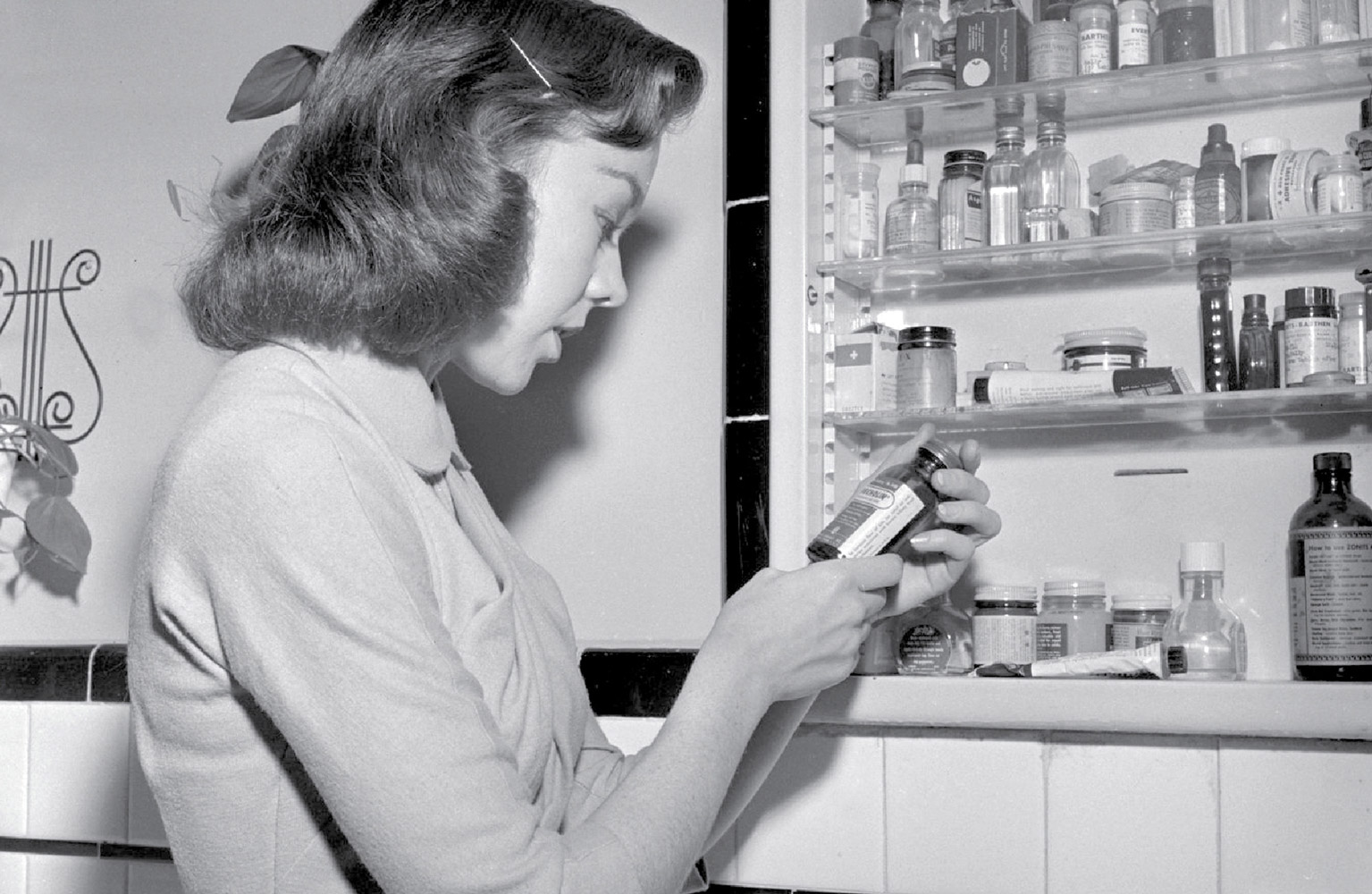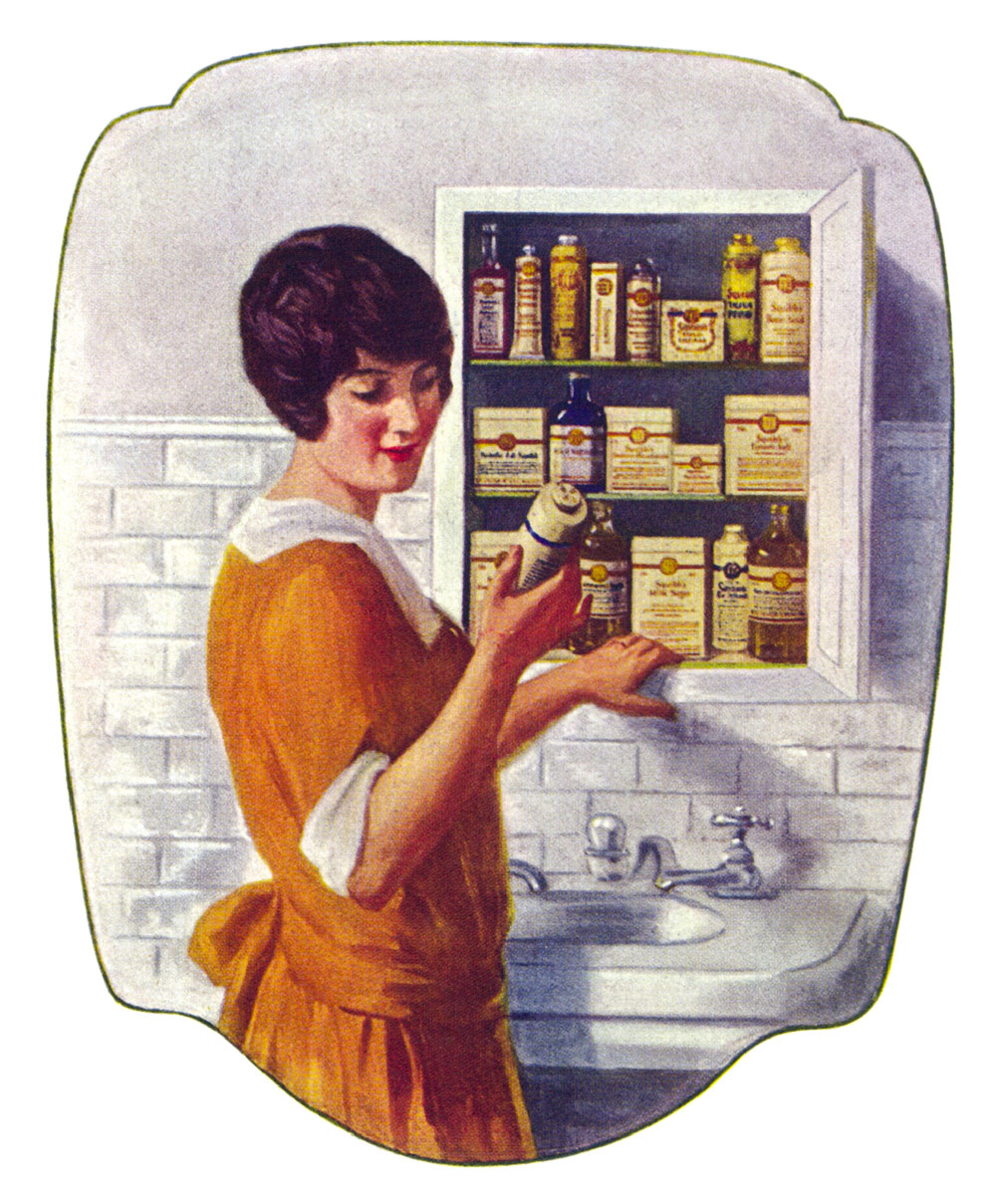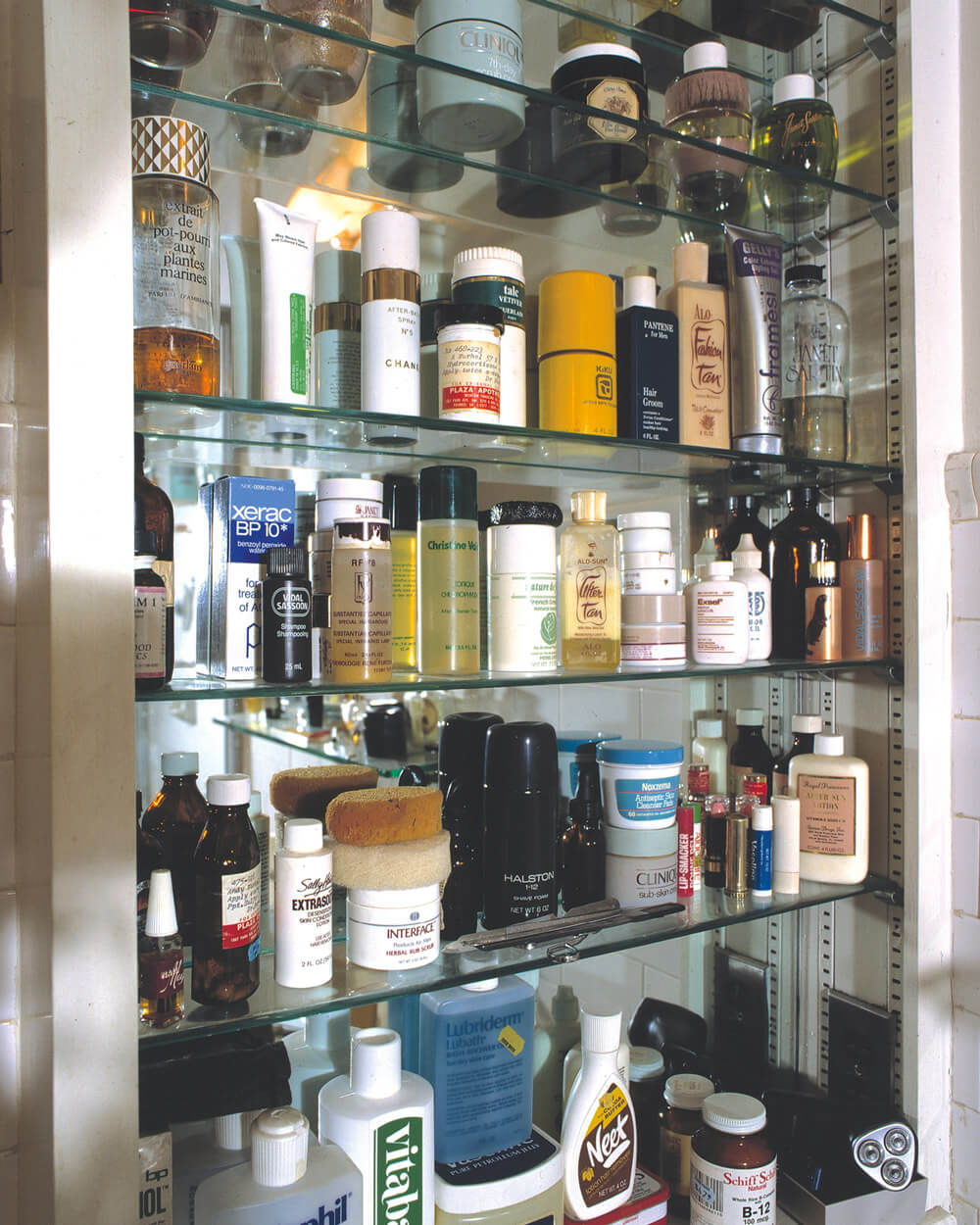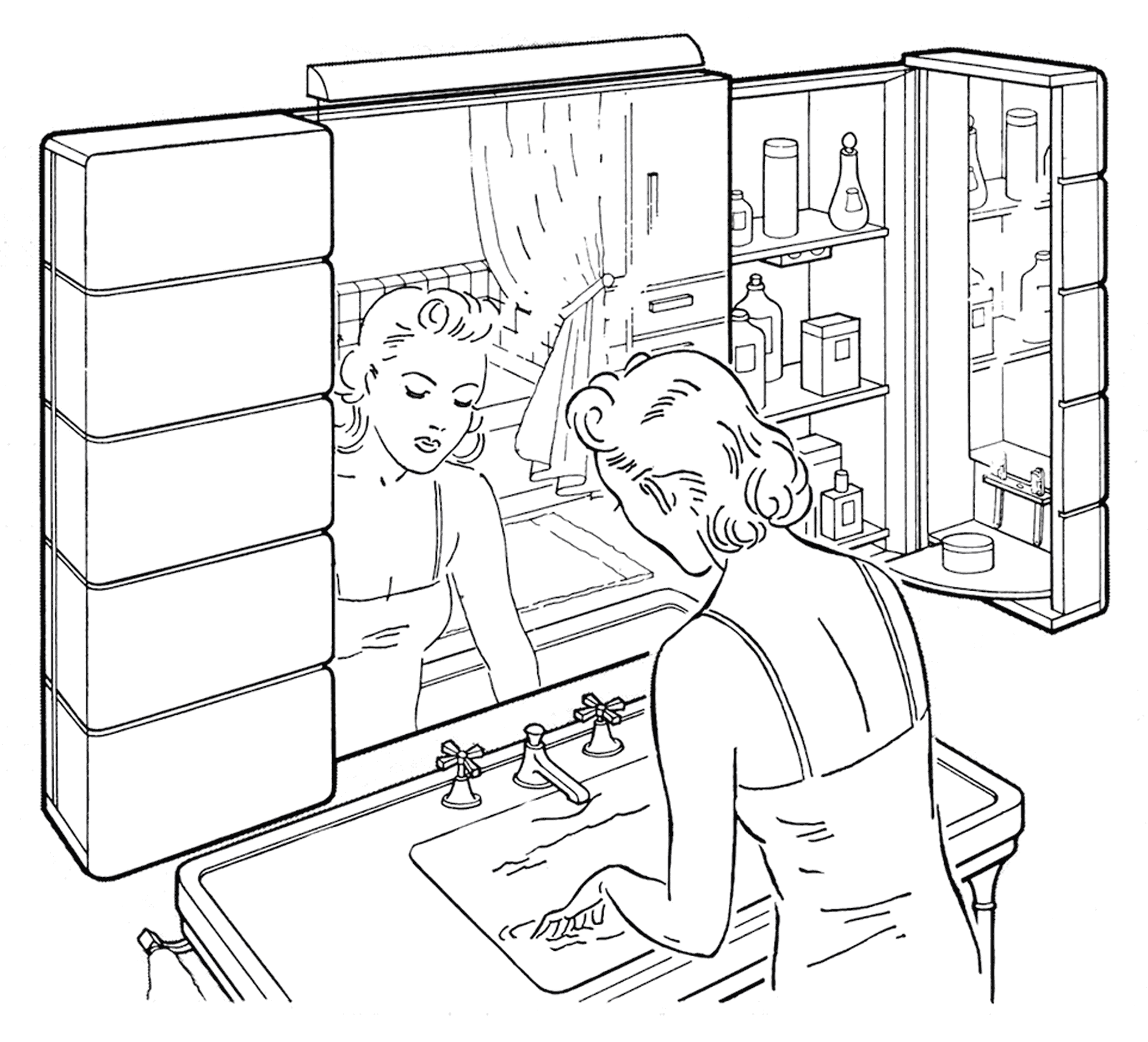Bringing the Drugstore Home: An Interview with Deanna Day
Patient labor, scientific motherhood, and the development of the medicine cabinet
Jeffrey Kastner and Deanna Day

A ubiquitous element of our modern-day bathrooms, the medicine cabinet is also one of the home’s most particularized containers—stocked with substances and technologies used in healthcare and grooming, it functions both as personal pharmacy and private salon. Indeed, the medicine cabinet emerged across the early part of the twentieth century not just in tandem with public health policy initiatives but also, importantly, with the developing consumer market for the goods and tools of personal care. Its signature aesthetic—mirror, glass, and gleaming metal—would seem to have as much in common with the presentational seductions of the department store display case as with the sanitary spaces of the physician’s examining room.
As historian Deanna Day has written, stewardship of this container—as with so many of the domestic responsibilities associated with practices of health and bodily maintenance—has long been understood to be a task to be undertaken by women. A well-stocked and carefully curated medicine cabinet conveyed care and successful home management, while an overstuffed or unconsidered one ran afoul of received ideals of motherhood. Yet while women were responsible for the cabinet’s care and contents, certain products essential to their own health and hygiene were long thought to be inimical to it. Jeffrey Kastner spoke with Day, currently a research fellow at the Chemical Heritage Foundation, by telephone in July 2016.
Cabinet: Tell me a bit about what led you to start looking at the history of the medicine cabinet.
Deanna Day: I’m a historian of science, and I study the history of technology and the history of medicine. Quite early on as a graduate student, I began to focus my research on consumer medical technologies because I was less interested in what doctors were doing and more interested in how regular people have thought about and cared for their health. I wrote my dissertation on the history of the thermometer as a medical technology that, particularly during the twentieth century, was mostly used in the home by women—both to take care of children and also to chart their fertility. In the process of researching that history, I came across a few interesting sources on the development of the medicine cabinet, which was this truly iconic container designed to hold the types of quasi-medical objects that I was interested in: objects that were partly medical, but also that were partly cosmetic and not thought of as particularly “high tech.” For instance, people would be instructed to keep the thermometer in their medicine cabinet, but also things like razors and toothbrushes and other little technologies that were at least as much about grooming as about health. As I began to look into the history of the cabinet as a container, I discovered that it developed very much in parallel with these kinds of technologies. In fact, collecting these technologies together in the same cabinet helped to create the idea that these domestic technologies were something of a “kind,” emphasizing that both beauty work and medical care were crucial parts of literally embodying middle-class virtue in the home. And somewhat predictably, this bodily caretaking, along with the tools used for it, came to be coded as within the realm of women.
I’ve never really considered the thermometer as a gendered technology, but thinking back on it, as a child, it was always my mother who would use it. And as you’ve written, this sort of technological gendering extends in some sense to the medicine cabinet itself.
Absolutely. In the twentieth century ideal of the American domestic space—which obviously is coded with a range of class, race, and gender implications—it’s the woman of the house who’s the person in charge of maintaining that space to certain standards of cleanliness, standards for what a healthy home was supposed to be like that were increasingly dictated by science. Because of that, women became the stewards of the medicine cabinet, in addition to being the stewards of the other spaces of the home that were about taking care of their family’s bodily needs.
The medicine cabinet qua cabinet is a relatively recent phenomenon; it didn’t really emerge until the late nineteenth or early twentieth century as the sort of artifact it is today, a box hanging on the wall. Where did a housewife keep those kinds of supplies prior to the emergence of this new piece of furniture in the bathroom?
Prior to the bathroom medicine cabinet, these kinds of medical objects and tools would most likely have been kept in the kitchen. There was a lot of overlap in terms of the tools used to prepare medicines and to prepare food, and many treatments were based on diet, on eating certain foods. As indoor home bathrooms became more common with the advent of indoor plumbing, the idea of the clean, hygienic home bathroom space emerged and quasi-medical objects began to migrate to that space. The clean indoor bathroom was a kind of larger container that helped give rise to the smaller container that held these sorts of objects.
And the bathroom also becomes a quasi-medicalized space—the aesthetic of white tile and chrome fixtures are all suggestive of institutionally hygienic environments.
Early catalogues that sold household items, like sinks and mirrors and fixtures, figured the space of the bathroom more as a space of luxury, with soft furnishings, lots of decoration, things like that. But as the germ theory of disease and the idea of scientific motherhood started to become more prominent, you start to see the aesthetic changes as well—shiny white tile, chrome fixtures, etc. You want to make it gleam so you can form an aesthetic of cleanliness as well as making sure that you have all the spaces germ-free.

I haven’t heard the phrase “scientific motherhood” before. What do you mean by that?
“Scientific motherhood” is a phrase that the historian Rima Apple coined to talk about mothering guidelines in the early twentieth century—how the sense of what it means to be a good mother changed from a method based on knowledge and experience handed down through families and social networks to a practice that was based on the scientifically based recommendations of experts. And that more scientific approach to motherhood is mirrored, not surprisingly, by a more scientific approach to household management.
You said at the beginning of our conversation that there was a moment when women were being encouraged to put certain things into their medicine cabinets. Who was encouraging them? Was it an organized public health policy effort, where people were being told to have certain kinds of things on hand to take care of medical needs in the home?
Like so many things in twentieth-century medical history, it was a combination of government recommendation, healthcare-expert recommendation, and the “recommendation” of the companies making the medicine cabinets and, especially, the things that went in them. There were reports put out by government agencies recommending what kinds of home healthcare objects families should have on hand in cases of emergency; the idea was that you were supposed to have “a fully stocked medicine cabinet.” This idea also plugs into the idea of having a well-stocked home in general. The medicine cabinet also becomes, in a slightly different way, an aid to sales. Thermometer manufacturers would sometimes send stores cardboard medicine cabinets that could be used to display their objects: it signaled to purchasers not only, “Here’s a device to use in your home,” but also, “And this is the space designed to house it.” So the well-stocked medicine cabinet is a public health idea coming from both federal officials and company-endorsed sales tactics, and it starts to have immense presence in the popular imagination. That’s why you get so many tropes in entertainment about the medicine cabinet as this public-private space in the home that contains all these mysterious and evocative things.
Right, there’s the familiar image of the snoopy houseguest who goes into the bathroom and starts poking around in the medicine cabinet to see what sort of pills you have or what kind of lotion you use, only to be discovered when things start falling out and crashing to the floor. You write about a James Thurber short story that plays on this.
Yes, “Nine Needles.” It plays on the idea that the medicine cabinet holds tools that you use to take care of your very private bodily needs, and they’re sort of hidden away. But at the same time that the medicine cabinet is a private space, it also has a public dimension; it’s a hideaway but—unlike perhaps other closed-off spaces in the home—it’s in a room that guests are actually invited into. Then it becomes a private space that guests are actually given a private opportunity to explore, if they want to. It feels like a minor transgression to open the cabinet and see what kinds of things your hosts are using on their bodies, a relatively low-stakes form of gaining secret knowledge about them.

It’s a space that’s technologized and made in the image of a certain scientific notion of the home, but it does also offer an opportunity for a vicarious kind of real intimacy with the person whose stuff is in it. And that doesn’t seem to me to be a kind of concoction—that really is the experience you have when you encounter, whether invited to or not, what’s in someone’s medicine cabinet. It does give you a window on things that your host may or may not wish to share with you about their health and their bodies.
Exactly. And the Thurber story also draws out another piece of that, which is that the condition of the medicine cabinet also purports to give you some kind of insight into the housekeeping skills of your host. That’s another familiar trope of the medicine cabinet: the cabinet that’s overstuffed with expired medicines and old, mostly empty tubes of salve and half-used boxes of Band-Aids. In this sort of myth, this sloppiness is indicative not simply of poor housekeeping but also of poor bodily maintenance and poor health—or even of being a bad housekeeper, a bad wife, or a bad mother for not taking enough care of the organization of this box.
Right. Funnily enough, totally unrelated to our conversation, this weekend I ended up cleaning out for the first time in several years the medicine cabinet in our kids’ bathroom, and there’s no doubt that if someone had seen it before I got to it yesterday, I would have been a prime candidate for exactly this sort of criticism. But what really struck me most as I was cleaning it out was the form of the cabinet, what you might call the display language that it uses: glass and mirror and chrome and all those things that are part of our modern notion of what a medicine cabinet should look like. In light of this interweaving you mention of public health policy and the consumer-driven conception of the medicine cabinet, it’s interesting to consider the affinity that it has formally with the display strategies of the department store, the jewelry case, etc. Do you have a sense of when this modern aesthetic started to emerge? Do we know what the first medicine cabinets looked like?
It’s hard to say for sure what the very first medicine cabinets would have looked like. Early patents are fairly bare bones, but it is safe to say that it essentially took the form of the early traveling medicine kit and just hung it on the wall. One particularly famous example of these kits, developed and marketed by Henry Wellcome, was called the “Tabloid,” and it was essentially a smaller or portable kit that held standardized medicines and supplies; this particular kit was used by explorers such as Henry Morton Stanley and Ernest Shackleton. One quite interesting moment in the history of the cabinet, where you get a sense of the evolving notions of what it might be and how it might look, was a 1941 contest in the pages of Popular Science asking readers to design a new medicine cabinet that responded to the needs of the increasingly modern home and the forms of patient labor that were emerging. What’s so interesting about it is that you can see the ways that the tropes are already starting to take root; the contestants are users drawing on their own experience and desires for the medicine cabinets that they already have in their lives, and they are thinking about ways to improve them that reflect their real habits of use. I think the comparison to the jewelry case is really apt, because these are, after all, carefully curated sets of purchased things that are implicated in forms of domestic status. You had mentioned a hospital room, and I think the medicine cabinet in some sense sits at the intersection of these two forms; it gives us this idea that when you are a person selecting an object from your medicine cabinet, you’re both a consumer— you’ve chosen and bought that thing—but you’re also a medical worker who is going to use that object on yourself. Whether that’s a personal grooming activity like brushing your teeth or taking a medicine in a very specific regimen, you’re doing a kind of medical work for yourself in the cause of taking care of yourself, and you’re doing it using this tool kit. The practices and the aesthetics grow up together.

And this notion of patient labor marks a shift. People have obviously always taken care of their health and medical needs with home remedies and knowledge passed down from parents and grandparents. But this kind of new medical home doctoring, and the shape of that as received from the medical establishment and the commercial world, is instantiated in this cabinet that you have in your own clean and hygienic bathroom where you have an ever-expanding arsenal of tools for both healthcare and grooming.
Right, in part because grooming and hygiene are, if not strictly medical, still very culturally implicated in all this. I think the evolution in patient labor in the late nineteenth and across the twentieth century has to do with how extensively the work that one does ostensibly for one’s own health becomes embedded in a much larger, bureaucratized, specialized medical system, so that the care that you perform for yourself is only a small piece of what you’re doing. You’re also in many instances collecting data for your doctor, whether that means charting your symptoms by hand or, these days, keeping track of things with a smartphone app. So your doctor might also be using your information as part of a research study, or your clinic might be in partnership with an insurance company to collect patient data, and so on. Over the course of the twentieth century, patients get embedded really quickly in practices of medicine that are much larger and more systematized than just taking care of themselves and their families. Therefore it’s not surprising that the shapes of these spaces in the house, both the bathroom and the cabinet, end up taking on more the form of the doctor’s office than they do of the kitchen, with mass-market bandages and pills replacing remedies mixed at home. The medicine cabinet increasingly starts to resemble the kind of institutionalized world of medical practices into which the American patient-consumer is being embedded.
You write that the under-the-sink cabinet actually emerges after the medicine cabinet. So there is really no place in the bathroom in which to enclose things prior to the medicine cabinet.
That’s largely my understanding, after looking at some plumbing history. I think the development of the medicine cabinet demonstrates the utility of storage in the bathroom, and other kinds of bathroom storage, such as the under-the-sink cabinet, come to follow its lead. In part this reflects a desire to have an even more private place to keep things in the bathroom than in the medicine cabinet. Lara Freidenfelds has done amazing work on the history of menstruation and menstrual products and practices in the United States. In her book The Modern Period, she describes interviews with women who talk about their experience of mid-twentieth-century menstrual hygiene, sharing how for women of that generation menstrual supplies were usually kept not in the bathroom, but further hidden away in the bedroom, and only taken into the bathroom to be used. There’s this sense that the bathroom was too public a space in which to keep these things, and, over time, the under-the-sink cabinet, rather than the medicine cabinet, becomes the space to keep menstrual supplies. So that’s how you get to be a woman in 2016 who, as a guest in someone’s home, instinctively knows to look under the sink for menstrual supplies, rather than needing to seek out your host to ask for them.
Keeping these sorts of things in the medicine cabinet wouldn’t fit the mode of a house-proud display of one’s prowess as a homemaker or a scientific mother.
No. It’s important to remember that what is kept out of the medicine cabinet is as significant as what is put into it. As we know, women’s bodies, menstrual habits, and reproductive health are often uncomfortable and understudied in medical discourse. So not only is there a perception that women’s bodily needs don’t need to be addressed within the home’s primary aesthetic and practical medical space, but women’s bodies are, in many cases, kept out of more professional medical spaces as well, and for many of the same reasons. The ways we organize things in our homes both mirror and shape the way we organize things in the world.
Deanna Day is a historian of technology and medicine in the Center for Applied History at the Chemical Heritage Foundation. Her current book project, 98.6: Fevers, Fertility, and the Patient Labor of American Medicine, recounts the history of the thermometer in American life. She lives in Los Angeles. For more information, visit deannaday.net.
Jeffrey Kastner is senior editor of Cabinet.
Spotted an error? Email us at corrections at cabinetmagazine dot org.
If you’ve enjoyed the free articles that we offer on our site, please consider subscribing to our nonprofit magazine. You get twelve online issues and unlimited access to all our archives.